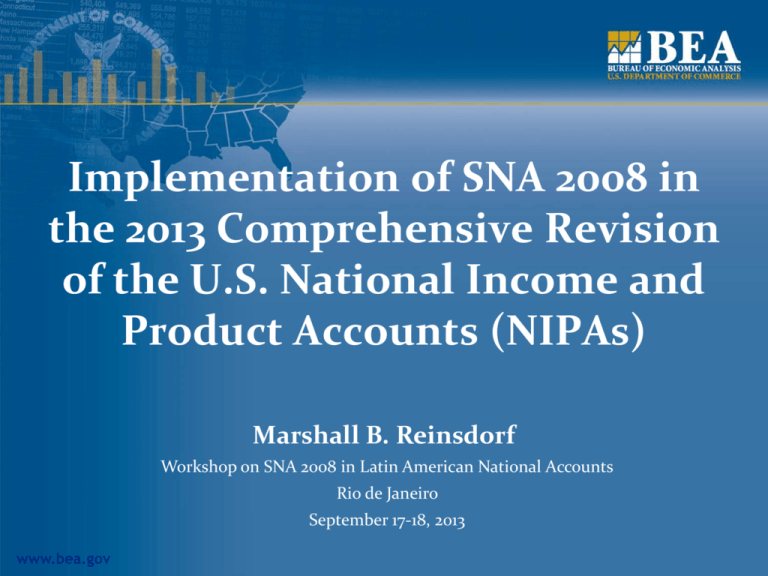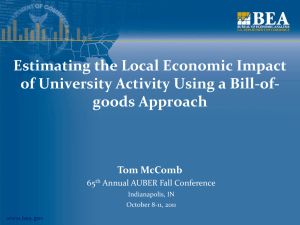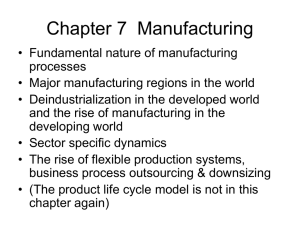11.3 www.bea.gov
advertisement

Implementation of SNA 2008 in the 2013 Comprehensive Revision of the U.S. National Income and Product Accounts (NIPAs) Marshall B. Reinsdorf Workshop on SNA 2008 in Latin American National Accounts Rio de Janeiro September 17-18, 2013 www.bea.gov Comprehensive revisions of NIPAs ▪ Comprehensive revision about every 5 years ▪ 14th comprehensive revision just happened in 2013 ▪ Incorporate results of the 5-year economic census and the benchmark input-output accounts ▪ Update the reference year for prices/quantities ▪ Opportunity to introduce major changes in concepts, methods, and tables ▪ The entire time span back to 1929 is potentially open for revisions www.bea.gov 2 BEA’s implementation of SNA 2008 ▪ The U.S. Bureau of Economic Analysis (BEA) had already adopted some of SNA 2008 changes before 2013: Non-life insurance and reinsurance. Military fixed assets Also had full sequence of accounts in Integrated Macroeconomic Accounts. ▪ In 2013 comprehensive revision, BEA implemented the major SNA changes affecting production and income: Capitalization of research and development Capitalization of costs of ownership transfer Pension entitlements Improvements to measure of FISIM Entertainment, literary, and artistic originals (was in 1993 SNA) www.bea.gov 3 For future implementation ▪ Several changes require development of new data sources and methods and are on BEA’s work plan: Treatment of employee stock options Currently recorded by BEA when exercised SNA 2008 treatment is based on fair value and is recorded between grant and vesting Recording of goods sent abroad for processing on a change-of-ownership basis Merchanting to be reclassified as trade in goods www.bea.gov 4 Borrowing/Investment from the Integrated Macroeconomic Accounts www.bea.gov 5 Holding Gains and Saving of Households from the Integrated Macro Accounts Saving and Holding Gains of Households as Percent of Household Disposable Income 80 70 60 50 40 30 20 0 1960 1961 1962 1963 1964 1965 1966 1967 1968 1969 1970 1971 1972 1973 1974 1975 1976 1977 1978 1979 1980 1981 1982 1983 1984 1985 1986 1987 1988 1989 1990 1991 1992 1993 1994 1995 1996 1997 1998 1999 2000 2001 2002 2003 2004 2005 2006 2007 10 -10 -20 www.bea.gov net saving holding gains/losses 6 0 1960 1961 1962 1963 1964 1965 1966 1967 1968 1969 1970 1971 1972 1973 1974 1975 1976 1977 1978 1979 1980 1981 1982 1983 1984 1985 1986 1987 1988 1989 1990 1991 1992 1993 1994 1995 1996 1997 1998 1999 2000 2001 2002 2003 2004 2005 2006 2007 2008 2009 2010 2011 Holding Gains and Saving from the Integrated Macro Accounts Saving and Holding Gains of Households as Percent of Household Disposable Income 100 50 -50 -100 -150 net saving www.bea.gov holding gains/losses 7 Research and development ▪ Expenditures on R&D have the characteristics of fixed assets and should be treated as investment: Ownership rights, long-lasting, used in production ▪ Previous treatment: Business R&D expenditures were classified as intermediate inputs R&D expenditures of nonprofit institutions and governments were included in consumption expenditures ▪ New treatment: R&D expenditures by businesses, NPISH, and governments are counted as fixed investment Depreciation of R&D added to consumption of fixed capital (CFC) www.bea.gov 8 From R&D expenditures to GDP impacts ▪ Identify R&D investment Sum R&D input costs based on performer data Remove double-counting of software Include depreciation of other fixed assets used to produce R&D Assign investment to owning sector—usually funder of the R&D Business Nonprofit institutions serving households Government (federal and state and local) Deflate nominal investment Input-cost approach with a productivity adjustment ▪ Estimate R&D capital stocks by owner Create capital stocks with perpetual inventory method Model derives industry-specific depreciation rates from investment & profits For general government, based on useful service lives of technologies www.bea.gov 9 Impact of capitalizing R&D in U.S. ▪ Total R&D investment for 2012: $417.7 billion 2.6% of (revised) GDP Business R&D: $248.7 billion Formerly treated as intermediate spending Government & nonprofit R&D: $169.0 billion Reclassified from consumption to investment ▪ Impact on GDP revision for 2012: $396.7 billion 2.5% of (previously published) GDP Business investment added to GDP: $248.7 billion Government & nonprofit—add CFC for R&D: $148.0 billion www.bea.gov 10 Top Private Business R&D-investing Industries Percent of Private Business Investment in R&D 2007 1987 www.bea.gov 11 R&D: Quarterly estimates ▪ Private business R&D investment After 2007 - quarterly financial statements (Compustat) Before 2007 - wages and employment ▪ Federal R&D investment Interpolated based on trends in intermediate R&D services ▪ NPISH and state and local government R&D investment Interpolated as a smooth trend www.bea.gov 12 Entertainment, literary, and artistic originals ▪ Original films, sound recordings, literary and music compositions, and artwork that can be used for the production and sale of copies ▪ Estimates for several types, including: Motion pictures Long-lasting television programs Books Music compositions and recordings Miscellaneous artwork ▪ Treatment as fixed investment in way that is similar to R&D, except entirely in private sector www.bea.gov 13 Entertainment originals: Implementation ▪ Little data on production costs Except theatrical movies, pre-2007 ▪ Value of Investment = Net Present Value of Revenue (NPV) Minus Non-Artwork Cost Revenue data adjusted to include only revenue from new works Net revenue is estimated by removing non-artwork costs Adjusted net revenue is multiplied by an “NPV factor” to derive investment value of future revenue stream The discount rate is 7% real www.bea.gov 14 Entertainment originals: Implementation ▪ Prices of entertainment assets PPIs, CPIs ▪ Annual depreciation will follow a geometric pattern, based on trends in NPV over time. Theatrical movies: 9.3 % Long-lived television: 16.8 % Books: 12.1 % Music: 26.7 % Miscellaneous: 10.9 % www.bea.gov 15 New NIPA Tables Private Fixed Investment in Intellectual Property Products www.bea.gov NIPA series Private fixed investment in intellectual property products Software Prepackaged Custom Own account Research and development Business Manufacturing Pharmaceutical and medicine manufacturing Chemical manufacturing, excluding pharmaceutical and medicine Semiconductor and other electronic component manufacturing Other computer and electronic product manufacturing Motor vehicles, bodies and trailers, and parts manufacturing Aerospace products and parts manufacturing Other manufacturing Nonmanufacturing Scientific research and development services All other nonmanufacturing Nonprofit institutions serving households Universities and colleges Other nonprofit institutions Entertainment, literary, and artistic originals Theatrical movies Long-lived television programs Books Music Other Start date 1929 1959 1985 1985 1985 1929 1959 1959 1959 1959 1959 1959 1959 1959 1959 1959 1987 1987 1959 1959 1959 1929 1929 1949 1929 1929 1929 16 Real private intellectual property products [Percent change from preceding period, SAAR] 25 Private Investment in IPP [Percent Change from Previous Quarter] 20 Percent 15 10 5 0 -5 -10 www.bea.gov 17 Costs of ownership transfer ▪ Old treatment Real estate brokers’ commissions on structures classified as fixed investment Depreciated over the life of the structure (80 years) ▪ New treatment Commissions on structures and land, title fees, attorney fees, other non mortgage related costs Depreciated over the typical holding period (12 years) ▪ Effects Increase GDP by the newly recognized investment (2007: $60 billion) Increase CFC more than investment (2007: $130 billion) Decrease net operating surplus (2007: $70 billion) www.bea.gov 18 Costs of ownership transfer www.bea.gov 19 Changes in Treatment of DB Pensions ▪ Accrual-based accounting replaces cash accounting Gives more accurate picture of compensation and sector saving. Actuarial methods, which depend on assumptions, must be used. ▪ New Pension Plan Sector Consistent with the Federal Reserve Board’s Flow of Funds Accounts. Part of Financial Corporations Sector ▪ New Tables National totals for defined benefit plans. Private, state & local government, and Federal DB plans. www.bea.gov 20 Accrual-based measures of pensions ▪ New measures for defined-benefit (DB) plans ▪ Accrual-based accounting Matches income earned with related production Recognizes employer liabilities for promised pension benefits Replaces cash-based accounting ▪ Compensation of employees Deferred compensation Benefits accrued on services rendered in current period ▪ Interest Benefits accrued on services rendered in past periods Includes interest on unfunded actuarial liabilities www.bea.gov 21 Defined benefit pension concepts ▪ Actuarial Liability (“Benefit Entitlement”) Actuarial value of accumulated benefit entitlements ∆AL = service cost + interest cost – benefits paid + effects of assumption changes and plan amendments Service cost is also known as “normal cost” ▪ Unfunded Actuarial Liability (UAL) = actuarial liability – plan assets ▪ Change in Plan Assets = contributions + property income – benefits paid – admin. exp. +/- holding gains/losses + net capital transfers www.bea.gov 22 Challenges in designing the new table ▪ Guidelines of the 2008 SNA (table 17.8) and the Flow of Funds Accounts have a pension plan sector located in the financial corporations sector. ▪ Employer’s normal cost is compensation income. ▪ Don’t want to affect saving of financial corporations sector. Saving by pension plans defined to equal zero. Dividend and interest income passed through to persons. www.bea.gov Challenges in designing the new table ▪ Gap between interest on the actuarial liability and property income on plan assets is likely to occur because plans use holding gains to fund benefits and have non-zero UAL . ▪ Assets that generate holding gains pay less income, so property income < assumed interest rate value of assets. ▪ If plan invests in assets that can be expected to generate holding gains, shortfall in property income from assets vs. the income implied by the assumed interest rate will be termed “implied funding of benefits from holding gains” . ▪ Interest imputed on the loan from plan to the employer if the unfunded actuarial liability (UAL) > 0, or on prepaid contributions if UAL < 0. www.bea.gov New DB Pension Flows Imputed Income from Defined Benefit Pensions as percent of disposable personal income 2.0 1.5 1.0 0.5 0.0 2000 2001 2002 2003 2004 2005 2006 2007 2008 2009 2010 2011 2012 -0.5 -1.0 imputed employer contributions www.bea.gov imputed interest on unfunded pension entitlements total imputed household income 25 DB pension flows in the NIPAs Financial assets Benefit payments and administrative services Monetary interest and dividend income Pension plan Imputed interest cost of plan’s funding gap (UAL) Rerouted employer contribution s Employer Labor services Imputed interest and dividend income from assets and employer Contribution supplements (equal to imputed income received) and direct contributions Employees and former employees Pension promises (actual and imputed contributions as compensation) www.bea.gov 26 What do contribution lines in the table equal? ▪ Imputed employer contributions = admin expenses + service cost–actual employer contributions–employee contributions ▪ Contributions includes household contribution supplements and a negative imputation for administrative expenses, which are recorded as implicit sales of services to households. ▪ Contributions = Gross accruals of benefit entitlements excluding benefits funded by holding gains. ▪ Net change in benefit entitlements = Contributions – benefits. www.bea.gov Pension Table, Top Part (research estimates for private plans in 2007) Current receipts, accrual basis Output Contributions Claims to benefits accrued through service to employers Actual employer contributions Imputed employer contributions Actual household contributions Less: Pension service charges Household pension contribution supplements Income receipts on assets (including plans' claims on employers) Interest Monetary interest Imputed interest on plans' claims on employers (for the UAL) Dividends Current expenditures, accrual basis Administrative expenses Imputed income payments on assets to persons Interest Dividends Benefit payments and withdrawals www.bea.gov Net change in benefit entitlements 223.3 9.8 147.5 81.4 67.1 23.3 0.8 9.8 66.1 66.1 33.9 37.6 -3.7 32.2 223.3 9.8 66.1 33.9 32.2 158.8 -11.3 Pension Table, Bottom Part Cash flow Actual employer and household contributions Monetary income receipts on assets Less: Benefit payments and withdrawals Less: Administrative expenses -30.9 67.9 69.7 158.7 9.8 Effect of participation in plans on personal income, saving, and wealth Effect on personal income Less: Effect on personal consumption expenditures Equals: Effect on personal saving Plus: Implied funding of benefits from holding gains on assets Interest accrued on benefit entitlements Less: Interest and dividend income received by plans Equals: Change in personal wealth Less: Benefit payments and withdrawals Plus: Household actual contributions Change in benefit entitlements including implied funding of benefits from holding gains www.bea.gov 156.5 9.8 146.7 73.0 139.1 66.1 219.7 158.7 0.8 61.8 Effects of DB Plan Changes on Saving (research estimates for 2007; $ billions) Private Business State & Local Governments Federal Government Households Saving, DB pensions on cash basis 270.7 12.2 -245.2 248.7 Revision in Saving –19.6 –101.3 –35.1 +156.0 Revision, as percent of disposable personal income –0.2 –1.0 –0.3 +1.5 Actual Revision Published Data –0.21 –0.95 –021 +1.3 www.bea.gov Source data for private plans ▪ We add up variables on the ABO, normal cost, contributions, benefits, and assets from almost 40,000 tax returns per year. ▪ Interest and dividend income of plans is estimated by multiplying average rates of return by corresponding values of assets. ▪ We use data sets from 2000 on (for early years extreme and missing values were problems, and some plans were missing.) ▪ For pre-2000 years, we extrapolated back normal cost rate using future benefits as a indicator. ▪ Reported numbers adjusted to reflect a common interest rate assumption based on AAA corporate bond yields (5 percent in recent years). www.bea.gov Data for state & local government plans ▪ For state & local government plans, we collected samples of actuarial valuation reports covering 90% of assets and membership back to 2000. ▪ We used membership data and estimates of normal cost rates to extrapolate back to 1929 (beginning of time for the NIPAs). ▪ Census Bureau will collect normal cost data in future, helped by new reporting standards promulgated by GASB. ▪ Most of the reports use the Entry Age Normal method and assume a high rate of interest; we adjusted them to ABO method and to use same interest rate as we used for private plans. www.bea.gov Data for federal government plans ▪ Actuarial reports go back to 1979 (civilians) or 1985 (military). ▪ Use PBO approach; legal funding targets are also based on PBO. ▪ Normal cost for each year, the PBO for 2013, and actual plan expenses used as inputs into simulations. For older years, we multiplied payroll by an estimated normal cost rate. Civilian simulation incorporated plan rule changes in 1930, 1942, 1948, 1956 and 1969. ▪ We assumed that trust fund received contributions equal to normal costs and earned interest on assets at the rate used by the federal actuaries. It pays benefits and administrative expenses. ▪ Trust fund balance served as estimate of PBO, with upward adjustments in 1970 for inflation surprise and in 2009-2010 for interest rate decline that was not matched by inflation decline. www.bea.gov Accrued interest for unfunded actuarial liabilities 220 200 180 160 Billions of dollars 140 120 100 80 60 40 20 0 -20 2002 2003 2004 2005 from private business www.bea.gov 2006 2007 2008 from federal 2009 2010 2011 2012 from state and local 34 FISIM: Banking services ▪ Include only assets and liabilities with direct customer contact ▪ Exclude expected credit losses from borrower services ▪ Improve user cost estimate of depositor and borrower services www.bea.gov 35 Effect of smoothing and default adjustment on borrower services 70000 60000 Published method $Millions (current) 50000 40000 30000 20000 Proposed method 10000 0 www.bea.gov Borrower services (no stabilization) Borrower services (with reference rate stabilization) Borrower services (stabilized, without default adjustment) Borrower services, no adjustment 36





